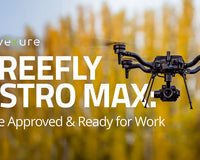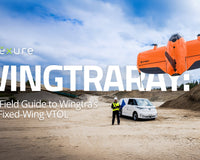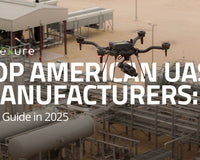For centuries, archaeologists have sought to view ancient landscapes from above, recognizing the power of an elevated perspective in uncovering hidden features. In the 17th century, William Stukeley sketched imagined aerial views of Stonehenge, and later, Eduard Spelterini soared over the Giza Plateau in a hot air balloon to capture some of the first true aerial images of the pyramids. As the field advanced, researchers turned to kites, and eventually manned aircraft to achieve a broader view of sites. These early efforts in remote sensing laid the groundwork for today’s archaeological surveying methodologies.
More recently, drones have taken this aerial perspective to new heights, providing archaeologists with efficient, cost-effective, and precise ways to survey the past. Unlike their predecessors, drones are equipped with advanced technologies like LiDAR and multispectral imaging, enabling researchers to detect buried structures, map entire landscapes, and monitor fragile sites with unparalleled detail. With UAS, archaeologists can finally fulfill the centuries-old dream of viewing history from above—unlocking insights that were once hidden beneath the surface.
Applications of Drones in Archaeology
Drones have revolutionized archaeological fieldwork by enabling precise, efficient, and accessible methods for surveying, documenting, and protecting cultural heritage sites. Below, we explore key activities where drones excel, highlighting real-world examples and practical insights for field teams.

1. Surveying and Mapping
One of the most fundamental tasks in archaeology, surveying and mapping, has been transformed by drone technology. Traditional methods, such as manual surveys or manned aircraft, often require significant time and resources. Drones, however, offer an agile and cost-effective alternative, capable of delivering detailed spatial data with unparalleled speed.
- Orthomosaic Mapping:
- Using RGB sensors, drones capture high-resolution aerial images, which are stitched together to create orthomosaic maps. These maps provide accurate representations of excavation sites, enabling archaeologists to plan digs or track changes over time.
- Digital Elevation Models (DEM):
- By integrating photogrammetry or LiDAR, drones produce DEMs that capture the topography of archaeological landscapes. This is invaluable for understanding the spatial relationships between features like burial mounds, ancient roadways, and fortifications.
- Challenges:
- Georeferencing: Accurate geolocations are essential for effective mapping. Integrating RTK GPS systems or ground control points (GCPs) ensures data accuracy.
- Resolution Trade-offs: While low-altitude flights increase resolution, they also demand more battery life and computational resources, necessitating careful mission planning.

2. Detecting Buried Features
Drones equipped with advanced sensors such as multispectral and thermal imaging excel at detecting subsurface features that may go unnoticed with traditional methods.
- Crop Marks and Soil Marks:
- Multispectral sensors identify crop marks caused by differences in vegetation health. For instance:
- Tall, dark crops indicate buried ditches or pits where roots have more space.
- Short, pale vegetation suggests buried walls or compacted soil affecting growth.
- Soil marks, visible through spectral analysis, reveal variations in soil color caused by underlying structures.
- Thermal Imaging:
- Thermal sensors detect heat retention differences between buried features and surrounding soil. Stone foundations, for example, store and release heat differently than soil, creating thermal anomalies.
- Example: In New Mexico’s Blue J site, thermal-equipped drones uncovered previously undetected buildings, expanding researchers’ understanding of the settlement’s layout.
- Shadow Marks:
- Visible in oblique light, these marks result from physical earthworks casting shadows. LiDAR excels at capturing these subtle variations, even under dense vegetation.
- Challenges:
- Temporal Factors: Crop marks and thermal signatures vary by season and time of day, requiring strategic timing for flights.
- Verification: Ground truthing remains essential to validate data collected from aerial surveys, particularly when environmental factors obscure results.

3. Preservation and Conservation
Fragile archaeological sites often face threats from natural erosion, human activity, or environmental changes. Drones offer non-invasive methods for monitoring and protecting these sites.
- Site Monitoring:
- Regular drone flights document site conditions over time, helping archaeologists track changes due to weather, vegetation growth, or human encroachment.
- Example: In Bolivia, LiDAR-equipped drones helped Heiko Prümers’ team uncover and document hidden burial mounds of the Casarabe culture, transforming what was once considered an unremarkable area into a significant archaeological discovery.
- Structural Assessments:
- Using thermal or photogrammetric imaging, drones identify cracks, material loss, or erosion in monuments and structures. This allows preservationists to prioritize restoration efforts without physically disturbing the site.
- Challenges:
- Data Longevity: Ensuring consistent data formats and backups is critical for long-term conservation studies.
- Terrain Limitations: While drones excel in open landscapes, dense urban or heavily vegetated environments may require complementary ground-based surveys.

4. Monitoring and Protection
Cultural heritage sites are often at risk from looting, vandalism, or unauthorized excavation. Drones provide a rapid-response solution for safeguarding these locations.
- Anti-Looting Surveillance:
- Equipped with real-time video feeds and thermal imaging, drones can patrol remote areas, detecting signs of unauthorized activity or excavation.
- High-resolution imagery also serves as evidence for law enforcement or heritage protection agencies.
- Environmental Monitoring:
- Drones assess external threats such as encroaching agriculture or nearby construction. Regular flights provide critical insights into the impact of these activities on archaeological sites.
- Challenges:
- Flight Regulations: Legal constraints regarding drone operations near heritage sites may require special permits or collaboration with local authorities.
- Battery Life: Extended surveillance missions may demand larger drones with higher endurance, such as fixed-wing models./
Key Remote Sensing Technologies
Archaeological surveys rely heavily on advanced sensing technologies to capture data that aids in the discovery, documentation, and preservation of sites. These technologies are broadly categorized into passive sensors, which rely on natural energy sources like sunlight, and active sensors, which emit their own energy to collect data. Below is an overview of these technologies, their technical mechanics, outputs, and challenges.
Passive Sensors
Passive sensors record naturally reflected radiation from the sun, providing visual, spectral, or thermal data about the landscape.
1. Visual (RGB)
-
How It Works: Cameras mounted on drones capture high-resolution images of the terrain. These images, when overlapped, are processed through photogrammetry to create 2D orthophotos or 3D models.
-
Archaeological Applications:
-
Detecting surface features like crop marks, shadow marks, and soil marks.
-
Producing orthophotos and digital elevation models for site documentation.
-
Outputs Generated:
-
Orthomosaic maps (2D).
-
3D models of terrain or structures.
-
Challenges:
-
Highly dependent on lighting conditions, with shadows or glare impacting data quality.
-
Limited ability to penetrate vegetation or reveal subsurface features.
-
How It Works: Multispectral sensors capture data across a limited number of discrete wavelengths, typically including near-infrared (NIR) for vegetation analysis.
-
Archaeological Applications:
-
Identifying crop marks by analyzing vegetation health, as buried structures affect root growth.
-
Mapping subtle changes in soil composition indicative of human activity.
-
Outputs Generated:
-
Reflectance maps.
-
Vegetation indices (e.g., NDVI).
-
Challenges:
-
Requires calibration to account for changing environmental factors like light intensity or soil moisture.
-
Limited spectral resolution compared to hyperspectral imaging.
3. Hyperspectral Imaging
-
How It Works: Unlike multispectral sensors, hyperspectral imaging collects data in hundreds of contiguous spectral bands, allowing for detailed material analysis.
-
Archaeological Applications:
-
Differentiating between natural and man-made materials.
-
Detecting hidden artifacts based on subtle spectral differences.
-
Outputs Generated:
-
Detailed material classification maps.
-
Challenges:
-
High computational demands for processing large datasets.
-
Costlier sensors and more complex integration with drones.
-
How It Works: Thermal sensors measure long-wave infrared radiation to detect heat emitted by the ground. Variations in heat retention reveal buried structures.
-
Archaeological Applications:
-
Detecting subsurface stone foundations or voids based on differential heat emission.
-
Identifying cracks or weaknesses in historical structures.
-
Outputs Generated:
-
Thermal orthophotos.
-
Heat distribution maps.
-
Challenges:
-
Thermal anomalies vary based on soil conditions, time of day, and weather.
-
Lower spatial resolution compared to visual or multispectral imaging.
Active Sensors
Active sensors emit their own energy, such as laser pulses, to gather data, making them effective in a wider range of conditions.
1. Airborne Laser Scanning (ALS)
-
How It Works: ALS systems send laser pulses from drones to the ground, measuring the time it takes for the pulses to reflect back. These data points create a detailed 3D model of the terrain.
-
Archaeological Applications:
-
Identifying subtle earthworks and features like burial mounds.
-
Creating high-precision digital terrain models (DTMs) by removing vegetation from the data.
-
Outputs Generated:
-
Digital Surface Models (DSMs).
-
Digital Terrain Models (DTMs).
-
Challenges:
-
Accuracy depends on dense point clouds, which require optimal flight settings and processing time.
-
Initial costs for LiDAR systems are higher than for passive sensors.
2. LiDAR (Light Detection and Ranging)
-
How It Works: LiDAR systems emit millions of laser pulses per second and measure their return times to calculate distances. This generates a "point cloud" that can be processed into detailed 3D models.
-
Archaeological Applications:
-
Penetrating dense vegetation to reveal hidden features like ancient roads or walls.
-
Mapping large landscapes efficiently and accurately.
-
Outputs Generated:
-
Point clouds.
-
High-resolution terrain models.
-
Challenges:
-
Requires significant computational resources for data processing.
-
Integration with georeferencing systems like RTK GPS is critical for accuracy.
Advantages of Drones in Archaeological Surveys
Precision and Accuracy in Data Collection
Drones equipped with advanced sensors like LiDAR, multispectral, and RTK GPS provide centimeter-level accuracy, enabling archaeologists to generate precise maps and models.
- Georeferencing: Drones equipped with RTK or PPK systems integrate GPS data directly into models, ensuring accurate alignment with real-world coordinates.
- Spatial Resolution: With low-altitude flights and high-resolution cameras, drones achieve detailed ground sampling distances (GSDs) as fine as a few millimeters per pixel.
2. Non-Invasive Survey Methods
Drones provide archaeologists with a way to gather critical data without physically disturbing fragile sites.
- Surface Preservation: Unlike traditional surveys, drone imaging avoids repeated foot traffic, which can damage delicate terrain.
- Remote Sensing: Sensors like thermal cameras and LiDAR detect subsurface features without excavation, reducing the risk of accidental artifact damage.
3. Accessibility to Challenging Terrains
Drones are capable of surveying areas that are difficult or unsafe to access by foot or traditional methods.
- Rugged Environments: Fixed-wing drones, like the WingtraOne, excel in covering large areas of mountainous or desert terrain.
- Dense Vegetation: LiDAR’s ability to penetrate foliage reveals hidden structures in areas like the Bolivian Amazon, where traditional aerial photography is ineffective.
4. Cost-Effectiveness
Compared to manned aircraft and satellite imaging, drones offer a more affordable solution for high-quality aerial data collection.
- Operational Flexibility: Drones can be deployed quickly and repeatedly without the logistical and financial overhead of helicopters or planes.
- Battery Efficiency: Modern drones can conduct extended missions with swappable batteries, reducing downtime and operational costs.
5. Real-Time Data Acquisition and Processing
Drones streamline the data collection process, reducing the time between fieldwork and analysis.
- Flight Planning Apps: Tools like DJI Pilot 2 and Pix4Dcapture automate data collection, ensuring mission consistency.
- Rapid Processing: Photogrammetric software like Agisoft Metashape transforms raw imagery into orthophotos and 3D models in hours, enabling quicker decision-making.
6. Integration with Multisensory Approaches
Drones seamlessly integrate with other archaeological tools to validate findings and cross-reference data.
- Complementary Methods: Combining drone data with ground-penetrating radar (GPR) or traditional excavation strengthens interpretation accuracy.
- Temporal Flexibility: Drones allow for repeated flights over time, enabling longitudinal studies of site changes.
Recommended Drone Platforms and Software
Drones and post-processing software work hand in hand to deliver precise, actionable data for archaeological fieldwork. Below is a curated list of drone platforms and software solutions, categorized by use case, to help field teams select the best tools for their projects.1. WingtraOne Gen II
The WingtraOne is a fixed-wing drone designed for large-scale terrain mapping. Its VTOL (vertical take-off and landing) capability ensures versatility, even in challenging environments.
- Key Features:
- Covers up to 1,400 acres per flight.
- Payload compatibility with high-resolution cameras like Sony RX1R II.
- Flight time: 59 minutes.
- Vertical take-off and landing (VTOL) for tight or uneven launch areas.
- Best For: Surveying large, open landscapes such as ancient agricultural fields or burial grounds.
2. Matrice 350 RTK
Equipped with the Zenmuse L2 LiDAR sensor, this platform offers high-precision mapping and exceptional versatility.
- Key Features:
- LiDAR capability for penetrating dense vegetation.
- RTK GPS ensures centimeter-level georeferencing.
- Flight time: 55 minutes.
- IP45-rated weatherproofing for harsh conditions.
- Best For: Mapping buried features under forest canopies or uneven terrain.
Drones for Precision Imaging and Subsurface Detection
These drones specialize in detailed imaging and thermal or multispectral sensing, ideal for detecting crop marks, shadow marks, and buried structures.
3. Mavic 3 Multispectral
The Mavic 3 Multispectral is tailored for precision mapping and vegetation analysis, making it invaluable for detecting crop marks.
- Key Features:
- Multispectral camera with 4 bands (green, red, red edge, and near-infrared).
- Integrated RGB camera for detailed visual data.
- Flight time: 43 minutes.
- Best For: Locating subtle crop marks indicative of buried structures.
4. Mavic 3 Enterprise
This compact and portable platform is excellent for high-resolution site imaging.
- Key Features:
- 4/3 CMOS camera for orthophotos and 3D models.
- RTK module support for precise georeferencing.
- Flight time: 45 minutes.
- Best For: Quick documentation of excavation sites and smaller mapping projects.
5. Matrice 30T
With integrated thermal imaging and a rugged design, the Matrice 30T is ideal for monitoring and preservation work.
- Key Features:
- Integrated thermal, zoom, and wide-angle cameras.
- Laser rangefinder for location tagging.
- IP55-rated weatherproofing.
- Flight time: 55 minutes.
- Best For: Assessing structural integrity and detecting buried features via thermal imaging.
Recommended Software for Post-Processing
Post-processing software is essential for transforming raw drone data into actionable outputs such as 3D models, orthophotos, and terrain maps.
1. Agisoft Metashape
A powerful photogrammetry tool for creating high-resolution orthomosaics, 3D models, and DEMs.
- Best For: Archaeological mapping and modeling.
- Key Features:
- Processes RGB, multispectral, and thermal datasets.
- Supports georeferenced outputs for integration into GIS platforms.
2. Pix4Dmapper
A versatile solution for photogrammetry-based mapping and analysis.
- Best For: Creating orthophotos, reflectance maps, and NDVI maps.
- Key Features:
- Supports RTK/PPK data for high accuracy.
- Offers multispectral data processing for crop and soil analysis.
3. CloudCompare
An open-source point cloud processing software for LiDAR datasets.
- Best For: LiDAR data classification and advanced terrain analysis.
- Key Features:
- Handles large datasets with advanced filtering and editing tools.
- Compatible with DSM and DTM workflows.
4. QGIS
A free, open-source GIS platform for integrating and analyzing georeferenced data.
- Best For: Combining multiple datasets for spatial analysis.
- Key Features:
- Supports raster and vector data.
- Extensive plugin library for archaeological applications.
5. DroneDeploy
An all-in-one flight planning and post-processing platform.
- Best For: Automated missions and quick orthophoto generation.
- Key Features:
- Real-time map previews.
- Cloud-based processing for collaborative workflows.
Case Studies
Drones have been pivotal in several groundbreaking archaeological projects, demonstrating their value in uncovering hidden features, mapping vast landscapes, and preserving cultural heritage. Below are some notable examples that highlight the transformative impact of drone technology.

1. Mapping the Nazca Lines in Peru
In 2020, archaeologists employed drones with high-resolution cameras to survey the Nazca Lines, a UNESCO World Heritage site. This approach revealed previously unknown geoglyphs, including a large feline figure, providing new insights into the ancient civilization that created these remarkable artworks.
- Technology Used: High-resolution RGB photogrammetry.
- Impact: Enabled the discovery of previously undocumented geoglyphs while minimizing site disturbance.

2. Uncovering the Forgotten Casarabe Culture in Bolivia
In the lowlands of Bolivia, archaeologists led by Heiko Prümers utilized LiDAR technology to reveal a network of hidden structures and burial mounds. What were once considered rubbish heaps were identified as burial sites with offerings, belonging to the Casarabe culture (500–1400 AD). These findings have reignited interest in an area previously thought to hold little archaeological value.
- Technology Used: LiDAR for vegetation penetration and 3D terrain modeling.
- Impact: Transformed perceptions of the Bolivian lowlands, uncovering a complex, previously unknown society.
- Source

4. Mapping the Lindenmeier Site in Colorado
The Department of Anthropology at Colorado State University deployed drones to map the Lindenmeier site, one of the most significant Folsom-era settlements in North America. The drones created a composite orthomosaic model, enabling researchers to document the site’s spatial layout with unprecedented precision.
- Technology Used: RGB photogrammetry for high-resolution orthophotos.
- Impact: Provided scalable, georeferenced data to guide excavation and analysis.

5. Discovering Hidden Structures at Blue J, New Mexico
In New Mexico, just south of Chaco Canyon, drones equipped with thermal imaging sensors revealed previously undetected buildings beneath the soil at the Blue J site. The findings expanded researchers’ understanding of the settlement’s scale and complexity.
- Technology Used: Thermal imaging to detect heat differentials from buried structures.
- Impact: Identified multiple hidden structures, reshaping the narrative of the area’s historical significance.

6. Documenting Burial Mounds in Tuekta, Russia
In 2011, archaeologists in Tuekta used drones to create 3D models of burial mounds (kurgans), which offered detailed insights into the layout and construction of these ancient sites.
- Technology Used: RGB photogrammetry for 3D modeling.
- Impact: Provided a non-invasive way to document the spatial organization of burial sites, preserving their integrity while enabling detailed analysis.
- Source
Uncovering the Past with Aerial Technology
Archaeology has always been a discipline of innovation, and drones represent the next step in that tradition. From mapping ancient landscapes to uncovering hidden features and preserving cultural heritage, drones and their associated technologies are transforming how we explore and document history. By integrating advanced sensors and powerful post-processing software, field teams can achieve unprecedented levels of precision, efficiency, and insight.
If you’re ready to elevate your archaeological fieldwork, Advexure’s team of experts is here to help. We provide tailored drone solutions and support to ensure you have the right tools for every stage of your project. Contact us today to discover how we can empower your work and help you uncover the stories waiting to be told.










